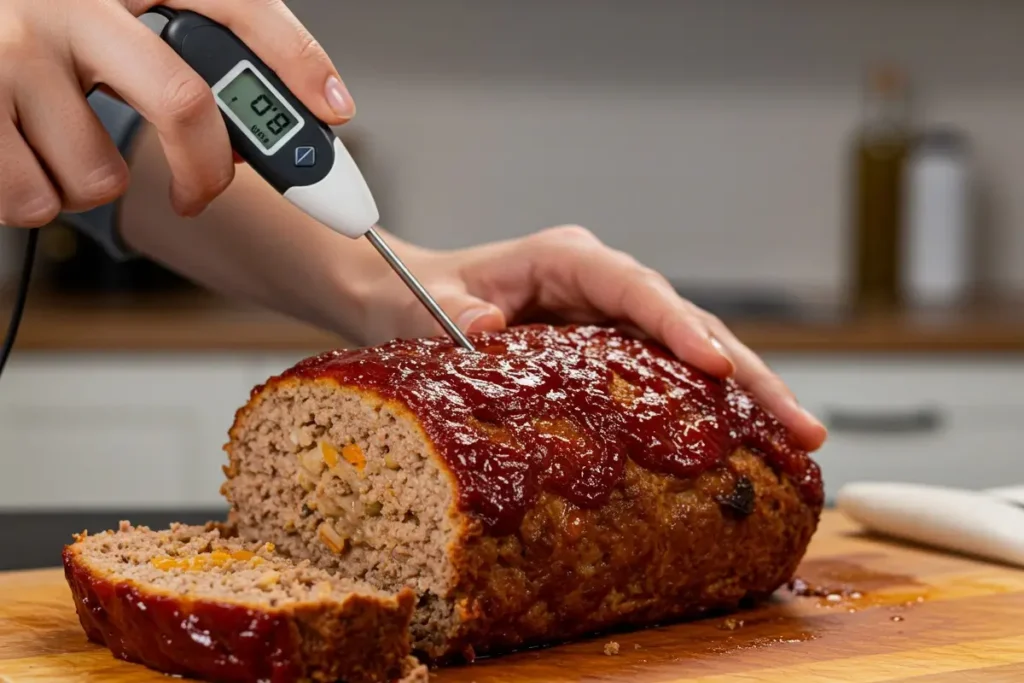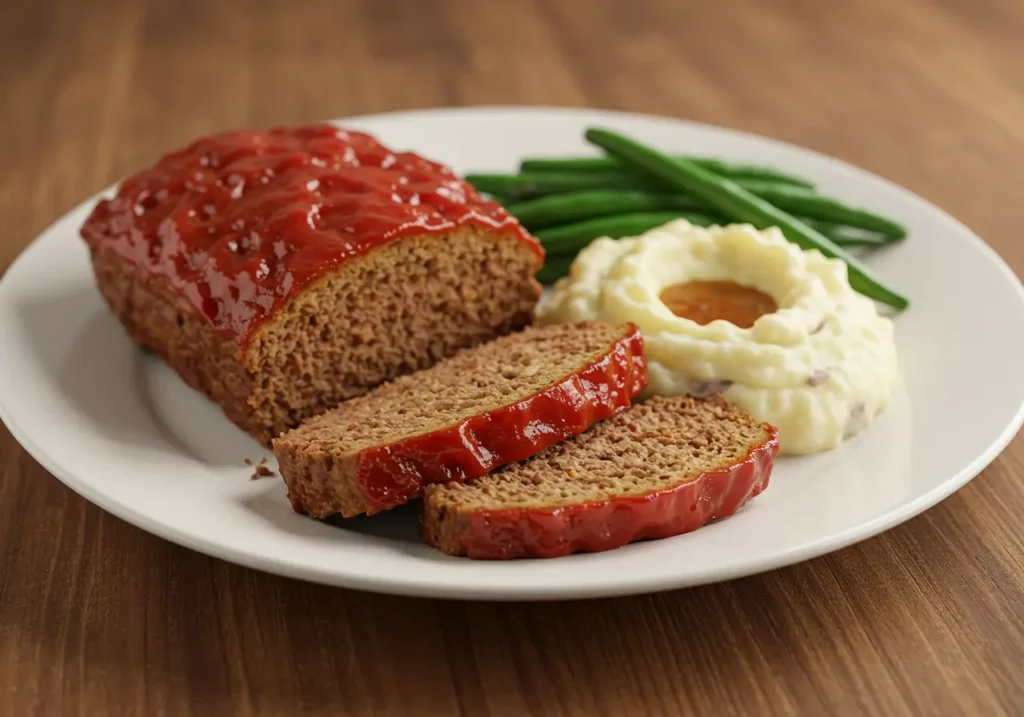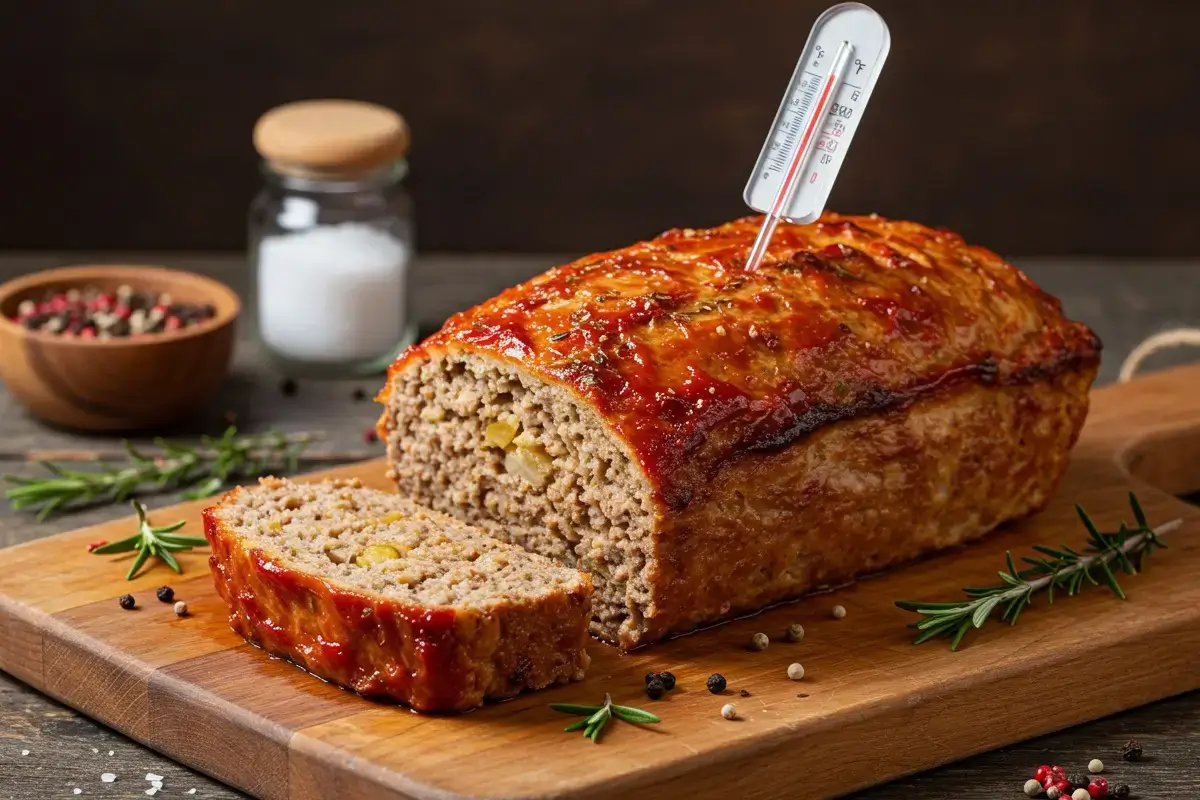Table of Contents
How do you know when meatloaf is done?
Ever found yourself asking, ‘How can I tell if my meatloaf is done?’ It’s a common dilemma, even for seasoned cooks. Meatloaf can be tricky—it’s either undercooked and unsafe or overdone and disappointingly dry. But don’t worry, nailing the perfect doneness isn’t as hard as it seems. With the right guidance, you’ll soon know exactly how to cook meatloaf that’s safe, juicy, and delicious every single time. Whether it’s a comforting family dinner or the star dish at a potluck, a perfectly cooked meatloaf is always a crowd favorite.
Understanding the Basics of Cooking Meatloaf
What Is Meatloaf and Its Culinary Appeal?
Meatloaf is a hearty dish made by combining ground meat, binders (like breadcrumbs and eggs), seasonings, and sometimes even vegetables. It’s then formed into a loaf shape and baked to perfection. It’s simple, filling, and incredibly versatile. Whether you love a classic ketchup glaze or a tangy BBQ twist, meatloaf offers endless customization options.
Why do so many people love meatloaf? It’s not just about taste—it’s about the memories. For many, meatloaf symbolizes home-cooked meals, comfort, and care. Plus, it’s economical, easy to make, and can feed a crowd with minimal effort. What’s not to love?
Common Ingredients and Variations of Meatloaf
The beauty of meatloaf lies in its adaptability. While traditional recipes use ground beef, there’s no rule saying you can’t mix it up. Let’s look at some common ingredients and variations:
| Ingredient | Quantity |
|---|---|
| Ground Meat (Beef, Pork, Turkey, or Chicken) | 1 lb |
| Bread Crumbs or Cracker Crumbs | 1/2 cup |
| Eggs | 2 (for binding) |
| Milk or Broth | 1/4 cup (for moisture) |
| Chopped Onions or Garlic | 1/2 cup (optional) |
| Seasonings (Salt, Pepper, Paprika, etc.) | To Taste |
| Ketchup or BBQ Sauce | 1/4 cup (for topping) |
Want to get creative? Add shredded cheese, sautéed mushrooms, or even finely diced bell peppers to the mix. For a healthier twist, use ground turkey and oatmeal instead of breadcrumbs. The possibilities are endless!
Why It’s Crucial to Cook Meatloaf to the Right Temperature
The Risks of Undercooked Meatloaf
Cooking meatloaf isn’t just about taste—it’s also about safety. Ground meat, unlike whole cuts, is more prone to contamination because bacteria can mix throughout during processing. If your meatloaf isn’t cooked to the correct temperature, you’re left wondering, “How do you know when meatloaf is done?” The answer lies in ensuring it reaches a safe internal temperature.
Symptoms from bacteria like E. coli or Salmonella can range from mild discomfort to severe illness. To protect yourself and your family, follow this golden rule:
“To guarantee food safety, meatloaf should be cooked to an internal temperature of 160°F (71°C) when using beef or pork, and 165°F (74°C) if poultry is included.
Think of this like wearing a seatbelt—it’s not optional. Always ensure your meatloaf is properly cooked for peace of mind and good health. Knowing how to tell when meatloaf is done can make all the difference.
The Problems with Overcooked Meatloaf
On the flip side, overcooking your meatloaf can rob it of all the juicy goodness that makes it delicious. Dry, crumbly, or rubbery meatloaf often leaves people asking, “How do you know when meatloaf is done without overcooking it?”
When the internal temperature exceeds the ideal range, you end up with a dense, unappealing brick of meat. It’s like overcooking a steak—there’s no coming back from it. That’s why learning the correct methods for checking doneness is key to perfecting your meatloaf.
How to Check If Meatloaf Is Done: Proven Methods

Using a Meat Thermometer: The Most Reliable Method
If there’s one kitchen tool that’s worth every penny, it’s a meat thermometer. This little gadget takes all the guesswork out of cooking meatloaf. Instead of asking yourself, “How do you know when meatloaf is done?”, you can rely on precise measurements to get it right every time.
Here’s how to use a meat thermometer effectively:
- Insert the thermometer: Place the probe into the thickest part of the loaf, avoiding any filling or touching the pan.
- Check the reading: For beef or pork-based meatloaf, look for 160°F (71°C). For poultry-based meatloaf, aim for 165°F (74°C).
- Double-check: If in doubt, check the temperature in a couple of different spots to confirm doneness.
It’s quick, easy, and the most reliable way to answer the question, “How do you know when meatloaf is done?” Trust us—this little device is a game-changer.
Visual Clues to Determine Doneness
No thermometer? No problem! While it’s not as precise, there are still ways to tell if your meatloaf is done:
- Clear juices: Cut into the loaf slightly. If the juices run clear, it’s likely done. If they’re pink or cloudy, keep cooking.
- Crust color: A fully cooked meatloaf often has a deep golden-brown crust.
- Texture: The loaf should feel firm but springy when pressed gently with a fork or spatula.
These clues can help in a pinch but remember—nothing beats the accuracy of a thermometer.
Testing Meatloaf Texture with Utensils
Ever baked a cake and used a toothpick to see if it’s done? You can apply the same principle to meatloaf, but with a fork or skewer. Insert it into the center of the loaf and pull it out. If it comes out clean and the meat feels firm, your meatloaf is likely ready to serve. However, this method isn’t foolproof, so pair it with visual cues for better accuracy.
The Ideal Internal Temperature for Perfect Meatloaf
Safe Cooking Temperatures for Different Meats
If you’re experimenting with different types of meat, remember that safe cooking temperatures can vary:
- Beef and Pork: Cook to 160°F (71°C).
- Poultry: Cook to 165°F (74°C).
If your recipe includes a mix (like beef and turkey), always go with the higher temperature to ensure safety.
Achieving Juicy and Tender Meatloaf
Want a meatloaf that’s melt-in-your-mouth tender? The secret lies in your technique. Here are a few tips:
- Don’t overmix: Overworking the meat can make it tough. Mix just until combined.
- Rest it: Let the meatloaf sit for 10 minutes after baking. This allows the juices to redistribute, keeping it moist.
- Add moisture: Ingredients like milk, eggs, or even grated veggies can make all the difference.
With these tricks, you’ll have a meatloaf that’s juicy, tender, and absolutely delicious.
Common Problems When Cooking Meatloaf and Their Solutions
Meatloaf Is Still Pink Inside: What to Do
Have you ever sliced into your meatloaf and wondered, “How do you know when meatloaf is done?” A pink center can make anyone pause. But here’s the thing—it’s not always a sign of undercooking. Sometimes, a chemical reaction between ingredients like onions or acidic components (such as tomatoes and vinegar) can cause the meat to retain a pink hue, even when fully cooked.
Still, it’s better to be safe than sorry. Here’s how to ensure your meatloaf is perfectly cooked:
- Use a meat thermometer: The most accurate answer to “How do you know when meatloaf is done?” lies in checking its internal temperature. A fully cooked meatloaf should read 160°F (71°C).
- Adjust acidic ingredients: If the pink color bothers you, reduce ingredients like ketchup, tomato paste, or vinegar in your recipe.
Remember, even if it’s pink, as long as the internal temperature reaches 160°F, your meatloaf is safe and ready to serve!
Dry or Crumbly Meatloaf: How to Fix It
Struggling with dry, crumbly meatloaf? It’s a common issue and leaves many cooks asking, “How do you know when meatloaf is done?” without it being overcooked. Dryness often happens when the meat mixture is overworked, lacks moisture, or is baked too long.
Here’s how to fix and prevent dry meatloaf:
- Incorporate moisture-rich ingredients: Adding milk, broth, or grated vegetables (like zucchini or carrots) to your mixture can keep the meatloaf juicy.
- Handle with care: Avoid overmixing your ingredients. Overworking the meat makes it dense and dry.
- Bake with foil: Tent your meatloaf with foil for the first half of baking to lock in moisture, then uncover to allow the crust to form.
By following these steps, you can achieve a moist, flavorful meatloaf that answers the question, “How do you know when meatloaf is done?” with confidence!
Unevenly Cooked Meatloaf: Tips for Prevention
An unevenly cooked meatloaf—burnt on the outside and raw in the middle—can leave you scratching your head and wondering, “How do you know when meatloaf is done?” The key lies in even shaping and proper cooking techniques.
Here’s how to ensure even cooking:
- Shape evenly: Avoid making the loaf too thick in the center. A consistent shape ensures even heat distribution.
- Use the right pan: A loaf pan provides structure and helps the meatloaf cook evenly. Alternatively, a sheet pan lined with parchment paper allows air to circulate better if baking free-form.
- Calibrate your oven: Use an oven thermometer to make sure your oven is at the right temperature. Incorrect oven settings can lead to uneven cooking.
By following these tips, you’ll no longer wonder, “How do you know when meatloaf is done?” Instead, you’ll serve a perfectly cooked dish every time.rnt.
Expert Tips for Cooking Meatloaf to Perfection
How to Choose the Right Pan for Meatloaf
The type of pan you use can make or break your meatloaf. Here’s the scoop:
- Traditional loaf pans: Great for shaping but can trap grease. If you use this option, consider draining the fat halfway through cooking.
- Free-form method: For a crispier crust, shape your meatloaf by hand and bake it on a lined baking sheet. This method is ideal for crust lovers!
- Perforated pans: Some pans are designed with drainage holes to let grease escape, giving you a healthier, less greasy loaf.
The Role of Resting Time in Perfecting Meatloaf
After all your hard work, don’t rush to slice your meatloaf as soon as it’s out of the oven. Letting it rest for at least 10 minutes is crucial for keeping it juicy. During this time, the juices redistribute throughout the loaf instead of spilling out when cut.
Think of resting like letting a good steak sit—it’s a small step that makes a big difference.
FAQs About Knowing When Meatloaf Is Done
How Do You Know When Meatloaf Is Done?
The best way to know when meatloaf is done is by checking its internal temperature. Insert a meat thermometer into the thickest part of the loaf. It should read 160°F (71°C). This ensures your meatloaf is safe to eat and perfectly cooked.
If you don’t have a thermometer, look for clear juices when you cut into the loaf and ensure the texture is firm, not mushy.
How to Tell When Meatloaf Is Done?
Besides using a thermometer, you can rely on visual and tactile cues:
- Color: The meatloaf should have a golden-brown crust on the outside.
- Juices: When you cut into the loaf, the juices should run clear, not pink.
- Firmness: Gently press the top with a fork—it should feel springy and firm.
While these methods can help, a thermometer remains the most reliable tool.
Is It Better to Cook Meatloaf at 350 or 375?
Both temperatures work, but it depends on your cooking goals. Cooking at 350°F is ideal for a moist and evenly cooked meatloaf. It allows the loaf to bake slowly, preventing it from drying out.
At 375°F, the meatloaf cooks faster, but there’s a higher risk of overcooking or drying out, especially on the edges. If you’re short on time, use 375°F but monitor closely and tent with foil to retain moisture.
What Not to Put in Meatloaf?
A great meatloaf starts with the right ingredients, but some things are best avoided:
- Too many breadcrumbs: Overloading on breadcrumbs can make your meatloaf dense and dry.
- Large vegetable chunks: They can make the loaf fall apart. Grate or finely chop veggies for better texture.
- Lean meat only: While healthy, using only lean meat can lead to a dry loaf. Add some fat for flavor and moisture.
- Too many eggs: Eggs are a binder, but too many can make the loaf rubbery.
Keep these tips in mind to avoid common pitfalls and create a delicious meatloaf every time!
Conclusion: Mastering the Art of Meatloaf Perfection

Final Thoughts on Meatloaf Cooking Techniques
Perfecting your meatloaf is easier than you think when you know what to look for and how to adjust your approach. With the right tools (hello, meat thermometer!), a few pro tips, and some patience, you’ll create a meatloaf that’s juicy, flavorful, and cooked to perfection.
Why Proper Doneness Leads to a Delicious Meatloaf
Cooking meatloaf to the proper temperature isn’t just about food safety—it’s about unlocking its full flavor and texture. Whether it’s a family dinner or a potluck, your perfectly cooked meatloaf is sure to impress. Now, go ahead and give it a try—you’ve got this!

